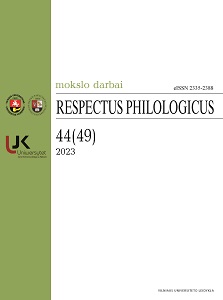Neoficialieji Vilniaus choronimai - jaunimo kalbos atspindys
Unofficial Choronyms of Vilnius: a Reflection of Youth Language
Author(s): Veslava SidaravičienėSubject(s): Language studies, Lexis, Semantics, Baltic Languages
Published by: Vilniaus Universiteto Leidykla
Keywords: unofficial choronyms; unofficial urbanonyms; choronyms; youth language; the ways of forming choronyms;
Summary/Abstract: The article discusses the formation of unofficial choronyms in Vilnius based on their linguistic characteristics. The study reveals that unofficial choronyms are formed based on three main processes: 1) by deriving from official choronym or their parts, e.g. Fabai (derived from Fabijoniškės), Baltuša (from Baltupiai); 2) by using a named place as the basis, e.g. Bomžynas (Naujininkai): bomžynas (LKŽŽ 90) “where poor people live”), Lušnynas (Kirtimai): lūšnynas (“refers to many dilapidated houses in the district”); and 3) by combining an official choronym with a named place, like Fabibiškės (derived from Fabijoniškės) ← Fabi[jon]iškės + bibi[s], and Seilėtekis (from Saulėtekis) ← S[au]lėtekis + seilė. The trends in the spoken language of young people demonstrate a tendency to use short forms of the official name-based choronyms, reflecting principles of language economy. The largest subgroup in terms of numbers is motivated unofficial choronyms, accounting for 56% of the examples. Another aspect important in the development of new names is the need to give names and imbue them with emotional and expressive qualities. Names based on associations make a smaller proportion (36%), while the third group is the least common (8%).
Journal: Respectus Philologicus
- Issue Year: 2023
- Issue No: 44 (49)
- Page Range: 54-68
- Page Count: 15
- Language: Lithuanian

